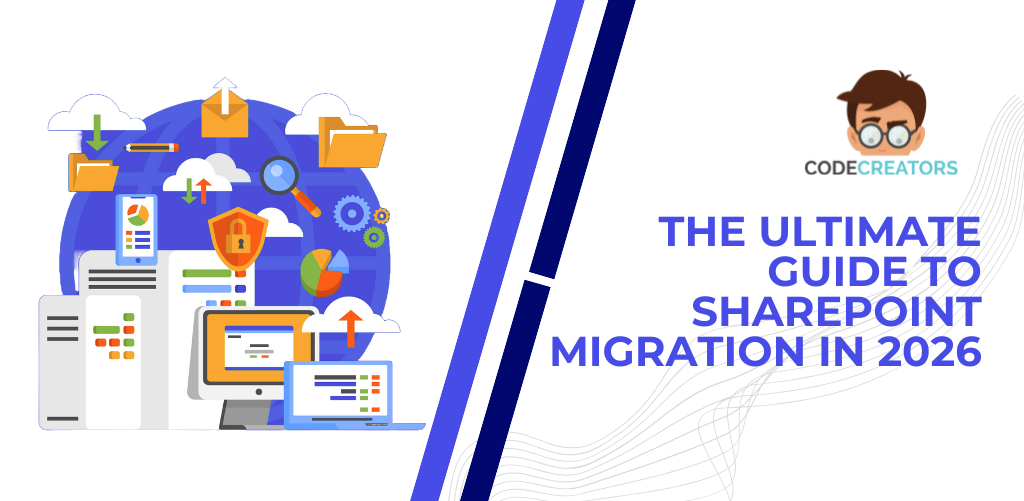SharePoint Migration for Highly Regulated Industries: Compliance Tips

Moving to SharePoint can be a big chance for organizations to be governed in heavily regulated sectors. However, the need for meticulous planning, execution as well as compliance with extensive regulatory requirements would give such an initiative success. This article will discuss some key considerations and useful pointers for managing SharePoint migration in industries such as healthcare, finance, legal, and government.
Understanding the Challenges of SharePoint Migration in Regulated Industries
Highly regulated industries face unique challenges that complicate the adoption of new technologies like SharePoint. These challenges include:
1. Managing Data Sensitivity and Security
Highly regulated industries handle sensitive data like patient health records, financial transactions, and legal documents. To have confidentiality and protection of this sensitive information, is not only legally required but deemed essential. Privacy must be integral into migration plans in addition to data protection and compliance with ethical standards.
2. Navigating Regulatory Compliance
Industries will need to comply with strict regulations like GDPR, HIPAA, and FINRA, which lay down severe conditions on how data is stored, accessed, and shared. Breaches may result in hefty penalties as well as reputational damage. Understanding and building compliance requirements into SharePoint migration strategies are essential for any success.
3. Ensuring Audit Trails and Operational Continuity
Such regulations call for audit trails in detail to monitor the access, changes, and transfer of data. Automated systems need to be in place for traceability. Migration plans should also minimize downtime to avoid disruption of operations resulting in financial loss and legal implications.
4. Addressing Legacy Systems and Vendor Challenges
Regulated industries typically use old-fashioned systems for integrating and managing other modern platforms like SharePoint making it dysfunctional. Along with that complication, differences in data formats further boost complexity to migration. Even third-party vendors used in the migration process will have to comply with the required regulation, thus making vendor management complicated further.
5. Mitigating Downtime and Cybersecurity Risks
Cyberspace threat constitutes one of the risks that exposure to data migration brings. Strong encryption and robust security ensure information safety. Planning for seamless migrations reduces disruption, thereby ensuring continuity in business, which protects damage in the form of financial or reputational loss.
Addressing these challenges requires a strategic approach to ensure compliance and a seamless transition to modern platforms like SharePoint.

Benefits of SharePoint for Regulated Industries
SharePoint provides many such features that make this platform suitable for controlled industries:
1. Centralized Data Management: SharePoint allows organizations to store, manage, and access data from a single platform.
2. Very Advanced Security Features: Protection by tools like data encryption and multi-factor authentication (MFA).
3. Compliance Tools: Compliance capabilities are built-in, such as audit logs and retention policies.
4. Collaboration Tools: Employees can cooperate without worry through version control and access permissions.
5. Scalable: Can adjust to any requirement, whether for a small team or huge businesses.
Pre-Migration Planning
Successful SharePoint migration needs appropriate planning. Here are the steps to prepare:
1. Conduct Data Audit: Find out the data types that your organization collects and holds, their sensitivity, and any regulation that governs them. This will help focus on what needs to be migrated and how it should be managed.
2. Establish Clear Objectives: Set out your objectives for SharePoint migration, including streams of different user experiences, compliance, enhanced collaboration, or security demands. These can be quite useful when taking up the migration activity.
3. Choose the Correct Migration Tool: Use those tools that fulfill the criteria of compliance in all their dimensions and by their means. Most often, it is Microsoft triggered migration tools like SharePoint Migration Tool-SPMT and third-party options for severe complex migrations.
4. Develop a Risk Management Plan: Identify enveloping risks such as a data breach, downtime, etc. Develop across-the-board strategies to mitigate risk. This ensures business continuity during migration.
5. Create a Migration Team: Bring together IT experts in the same workshop with compliance officers and a department representative who will argue all angles of SharePoint migration.
Compliance Tips for SharePoint Migration
1. Comprehend Regulatory Requirements
Consider the regulations applicable in your industry, as follows:
- Healthcare: HIPAA has strict measures for data privacy and security.
- Finance: FINRA and SEC rules have strict provisions concerning record keeping.
- Government: FedRAMP has made cloud services compliant with security in place to operate federal agencies.
2. Exploit SharePoint Features for Compliance
Utilize the native built-in compliance tools and features of SharePoint:
- Retention Policies: Keep data for specified periods and eliminate it thereafter.
- Audit Logs: Keep track of usage and modifications to data for compliance audits.
- Data Loss Prevention (DLP): Restrict disabling inappropriate sharing of sensitive information.
3. Ensure Role-based Access Control
Limit data access based on user roles. For instance:
- Employee records can only be accessed legally by HR personnel.
- Financial information is limited to authorized finance team members.
4. Encryption of Data
This method of protection applies to both data at rest and in transit. SharePoint applies encryption protocols for the safe keeping of sensitive data.
5. Regular Monitor and Audit
Review audit logs within SharePoint regularly to ensure compliance. With automated monitoring tools, you will be alerted in case of any suspicious actions going on around your site.
SharePoint Migration Best Practices
1. Testing Before Migration: A pilot test with a small snapshot to check problems. This should address most issues when it comes to migration.
2. Verify Data Integrity: Check that data are kept unchanged during migration movement. Employ tools with validation checks.
3. Downtime Minimization: Schedule the transfer, where possible, for off-peak hours to ensure reduced disruption. Send notice of the transfer schedule to the necessary stakeholders.
4. Prepare Employee Training: Training must be complete regarding all aspects of SharePoint use and compliance. The employees need to know how to operate and use the platform.
5. Migration Documentation: Record every element of the SharePoint migration activity, including decisions made, tools utilized, and compliance measures adopted in a very thorough manner. This may be used in an audit.
Post-Migration Steps
Follow these actions after completing the migration of data to keep it compliant and efficient:
1. Conduct post-migration Audit: Review by cross-checking the migrated data for accuracy, completion, and competencies with regulations and rectify any existing variances immediately.
2. Revise Existing Policies and Procedures: Modify the policies of your organization regarding data management to adapt to the new platform and inform all the employees regarding this change.
3. Solicit Feedback: After deploying the new system, consider feedback from users who state some of the challenges they face due to it and use it to improve what is not going well.
4. Plan for Improvement Continuously: You must regularly check the SharePoint setup to find future opportunities for improving compliance and additional efficiencies.
Real-World Examples
1. Healthcare Organization Ensuring HIPAA Compliance
A hospital moves its patient records to SharePoint, helping it comply with HIPAA. Today, hospitals have adopted DLP policies and encrypted data, which make it possible to protect some sensitive information and streamline the entire application process.
2. Financial Firm Automating Compliance Reporting
A financial services company using SharePoint’s workflow automation generated its compliance report automatically. This action minimized manual efforts and improved performance while keeping up with the regulatory requirements defined by FINRA.
3. Government Agency Securing Classified Information
The government agency imported classified documents to SharePoint, and at the same time, adhered to FedRamp standards. Role-based access control ensured that such sensitive data would be accessed only by authorized personnel.
Conclusion
Among many other things, the migration process provides a stimulus to revisit the old, useless workflows and polish them into streamlined and compliant activities. Investment in training and support to users will facilitate smooth transitions to the activity and enable employees to use SharePoint more efficiently. A successful migration, all things considered, guarantees not just compliance but, in the long, stretches toward innovative solutions, adaptability, and sustainability.



